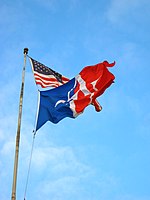Camp Leach
1917 establishments in Washington, D.C.1919 disestablishments in Washington, D.C.Buildings and structures demolished in 1919Chemical warfare facilitiesClosed training facilities of the United States Army ... and 9 more
Demolished buildings and structures in Washington, D.C.History of American UniversityMilitary camps in the United StatesMilitary installations closed in 1919United States Army postsUnited States home front during World War IUse American English from September 2022Use mdy dates from September 2022World War I sites in the United States

Camp Leach, formerly known as the American University Experimental Station and Camp American University, was a World War I era United States Army camp built by the Corps of Engineers on American University property in Washington, D.C. It was named in honor of Colonel Smith S. Leach, Corps of Engineers. The camp was established in 1917 for the organization of engineer units and subsequently used by the Chemical Warfare Service. Abandoned in January 1919, it was ordered salvaged.
Excerpt from the Wikipedia article Camp Leach (License: CC BY-SA 3.0, Authors, Images).Camp Leach
Massachusetts Avenue Northwest, Washington
Geographical coordinates (GPS) Address Nearby Places Show on map
Geographical coordinates (GPS)
| Latitude | Longitude |
|---|---|
| N 38.935827777778 ° | E -77.089316666667 ° |
Address
American University
Massachusetts Avenue Northwest 4400
20016 Washington
District of Columbia, United States
Open on Google Maps






